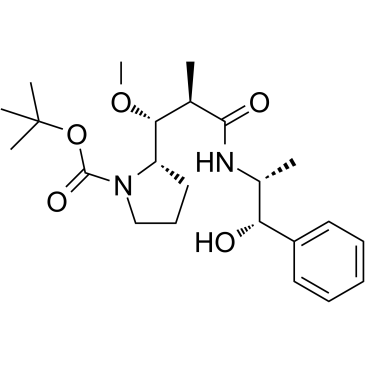Boc-Dap-NE is a kind of dipeptide and it is a cleavable ADC linker. Boc-Dap-NE is used in the synthesis of antibody-drug conjugates (ADCs).
Physicochemical Properties
| Molecular Formula | C23H36N2O5 |
| Molecular Weight | 420.542346954346 |
| Exact Mass | 420.26 |
| Elemental Analysis | C, 65.69; H, 8.63; N, 6.66; O, 19.02 |
| CAS # | 160800-65-7 |
| Related CAS # | Boc-Dap-NE;160800-65-7 |
| PubChem CID | 20777964 |
| Appearance | White to off-white solid powder |
| LogP | 2.7 |
| Hydrogen Bond Donor Count | 2 |
| Hydrogen Bond Acceptor Count | 5 |
| Rotatable Bond Count | 9 |
| Heavy Atom Count | 30 |
| Complexity | 570 |
| Defined Atom Stereocenter Count | 5 |
| SMILES | C[C@H]([C@H]([C@@H]1CCCN1C(=O)OC(C)(C)C)OC)C(=O)N[C@H](C)[C@H](C2=CC=CC=C2)O |
| InChi Key | XJDVGABQIFOWFC-SCQOQHIRSA-N |
| InChi Code | InChI=1S/C23H36N2O5/c1-15(21(27)24-16(2)19(26)17-11-8-7-9-12-17)20(29-6)18-13-10-14-25(18)22(28)30-23(3,4)5/h7-9,11-12,15-16,18-20,26H,10,13-14H2,1-6H3,(H,24,27)/t15-,16-,18+,19-,20-/m1/s1 |
| Chemical Name | tert-butyl (S)-2-((1R,2R)-3-(((1S,2R)-1-hydroxy-1-phenylpropan-2-yl)amino)-1-methoxy-2-methyl-3-oxopropyl)pyrrolidine-1-carboxylate |
| Synonyms | Boc-Dap-NE; |
| HS Tariff Code | 2934.99.9001 |
| Storage |
Powder-20°C 3 years 4°C 2 years In solvent -80°C 6 months -20°C 1 month |
| Shipping Condition | Room temperature (This product is stable at ambient temperature for a few days during ordinary shipping and time spent in Customs) |
Biological Activity
| Targets | Cleavable Linker |
| ln Vitro | ADCs are made up of an antibody and an ADC cytotoxin that are joined together by an ADC linker. |
Solubility Data
| Solubility (In Vitro) | DMSO : ~100 mg/mL (~237.79 mM) H2O : < 0.1 mg/mL |
| Solubility (In Vivo) |
Solubility in Formulation 1: ≥ 2.5 mg/mL (5.94 mM) (saturation unknown) in 10% DMSO + 40% PEG300 + 5% Tween80 + 45% Saline (add these co-solvents sequentially from left to right, and one by one), clear solution. For example, if 1 mL of working solution is to be prepared, you can add 100 μL of 25.0 mg/mL clear DMSO stock solution to 400 μL PEG300 and mix evenly; then add 50 μL Tween-80 to the above solution and mix evenly; then add 450 μL normal saline to adjust the volume to 1 mL. Preparation of saline: Dissolve 0.9 g of sodium chloride in 100 mL ddH₂ O to obtain a clear solution. Solubility in Formulation 2: ≥ 2.5 mg/mL (5.94 mM) (saturation unknown) in 10% DMSO + 90% (20% SBE-β-CD in Saline) (add these co-solvents sequentially from left to right, and one by one), clear solution. For example, if 1 mL of working solution is to be prepared, you can add 100 μL of 25.0 mg/mL clear DMSO stock solution to 900 μL of 20% SBE-β-CD physiological saline solution and mix evenly. Preparation of 20% SBE-β-CD in Saline (4°C,1 week): Dissolve 2 g SBE-β-CD in 10 mL saline to obtain a clear solution. Solubility in Formulation 3: ≥ 2.5 mg/mL (5.94 mM) (saturation unknown) in 10% DMSO + 90% Corn Oil (add these co-solvents sequentially from left to right, and one by one), clear solution. For example, if 1 mL of working solution is to be prepared, you can add 100 μL of 25.0 mg/mL clear DMSO stock solution to 900 μL of corn oil and mix evenly. Solubility in Formulation 4: 10% DMSO+ 40% PEG300+ 5% Tween-80+ 45% saline: ≥ 2.5 mg/mL (5.94 mM) (Please use freshly prepared in vivo formulations for optimal results.) |
| Preparing Stock Solutions | 1 mg | 5 mg | 10 mg | |
| 1 mM | 2.3779 mL | 11.8895 mL | 23.7790 mL | |
| 5 mM | 0.4756 mL | 2.3779 mL | 4.7558 mL | |
| 10 mM | 0.2378 mL | 1.1889 mL | 2.3779 mL |
